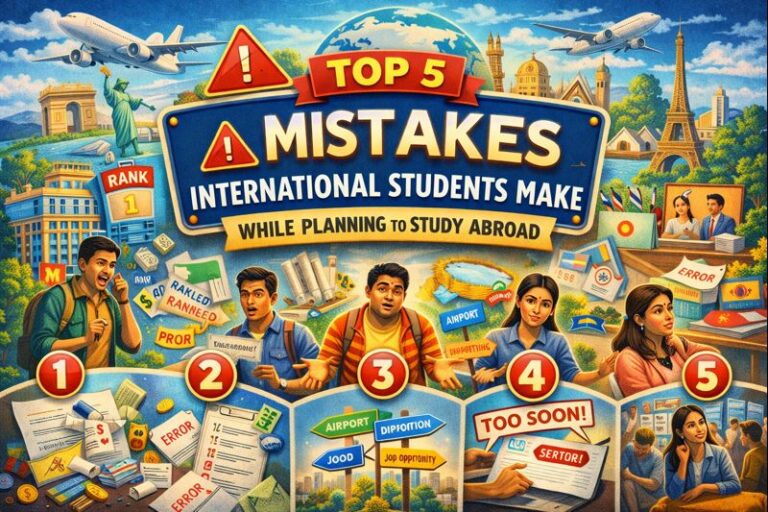Graduates of SDA Bocconi experience a pay jump of 124% post-MBA, with average salaries of $217,241 within three years.”
That headline number sums up the magnetic pull of Italy’s management degrees. Yet, salary is only one reason the best MBA programs in Italy are drawing record applications from India.
Here are a few more worth mentioning:
- Lower sticker price. Typical Italian tuition sits at €20,000–€40,000—almost a third of elite U.S. fees.
- Fast ROI. MIB Trieste’s pay-back period is just 21 months, half the global average.
- Golden hiring window. Schools like SDA and POLIMI place over 90 % of grads within three months.
- 12-month post-study work permit. Grads get a full year to land a Schengen-wide role.
Add a lifestyle bonus—sun-bathed campuses, affordable cities, and a cuisine everyone envies—and Italy becomes hard to ignore.
This article explores the numbers behind that appeal, shows how each school scores on rankings, and helps you judge real return on every euro invested.
Note: Choosing the right MBA program in Italy means balancing cost, career prospects, and lifestyle. GradRight’s university search platform can help you navigate this decision by providing personalized, data-driven recommendations tailored to your profile and goals. You’ll get insights on program rankings, post-study work permits, salary outcomes, and funding options, so you can make an informed choice without guesswork.
Once you identify your best-fit programs, GradRight’s loan search platform offers a streamlined way to compare education loans from over 15 trusted lenders, including banks and NBFCs. Benefit from competitive interest rates, no cosigner options, and expert negotiation assistance to reduce your financial burden—often with approvals in as little as 10 days.
With this support, you can focus on maximizing the impressive ROI Italian MBAs promise. Next, let’s break down the actual costs and living expenses you can expect while studying in Italy.
Why study an MBA in Italy?
The number of international students in Italian universities has steadily grown since 2017, reaching 96,000 in the 2023/24 academic year.

And it’s not difficult to figure out why.
Italy blends moderate costs with strong industry links and generous work visa rules, making it a smart launchpad for Indian students.
Let us dive into the top reasons why getting an MBA in Italy makes sense, specifically for Indian students.
Cost-Effectiveness:
Italian MBAs deliver European prestige without the American price tag. Here’s a quick comparison of the cost against the top study-abroad destinations:
| Destination | Typical MBA tuition | Average Living cost per year | Estimated total |
| Italy | €20,000 – €40,000 | €9,000 – €12,000 (student avg. €818/month) | €29,000 – €52,000 |
| UK | £31,000 – £90,000 (≈ €36,000 – €105,000) | £11,000 – £15,000 | £42,000 – £105,000 |
| USA | US$76,000 tuition at HBS
Full cost US$119,000 per year |
US$43,000 | US$119 – US$150,000 |
| Canada | C$60,000 – C$100,000 program cost (≈ €41,000 – €69,000) | C$15,000 – C$25,000 | C$75,000 – C$125,000 |
Note: These are 2024–25 published figures.
As you can see, even the priciest Italian MBA can undercut a mid-tier U.S. school by 50%, letting you recover fees faster.
Industry Connections:
Italy hosts global icons—Ferrari, Armani, Luxottica—and its schools weave them into curricula.
POLIMI reports a 78% salary jump for graduates thanks to projects in digital and manufacturing clusters.
SDA Bocconi graduates find a significant advantage when landing a job, with 95% of them finding employment within three months after graduation and a 135% salary hike.
Cultural and Professional Opportunities:
Indian students join a diverse cohort and study entirely in English.
While enrolled, they can work 20 hours per week. After graduation, they can stay up to 12 months on the ‘permesso di attesa occupazione’ to hunt full-time roles anywhere in Italy.
Milan’s Fashion Week, Rome’s fintech meet-ups, and Bologna’s food-tech incubators give unrivalled networking access and widen your career beyond campus.
Top universities and business schools for an MBA in Italy
Italy packs a dense roster of internationally recognised schools. Each carries distinct sector strengths and accreditation badges that reassure recruiters worldwide. Here’s a list of the top universities for an MBA in Italy:
| Name of University | 2025 ranking | Accreditation | Key highlights |
| SDA Bocconi | FT Global MBA #4 EU | Triple Crown | Luxury and finance industry links
95% of graduates find jobs in 3 months |
| POLIMI GSoM | FT Global MBA #36 | Triple Crown | Tech and digital industry links
78% salary rise |
| Bologna BBS | FT Europe MBA #37 | EQUIS | Tracks: Supercars, Food
107 % salary lift |
| MIB Trieste | QS Top-30 EU ROI | AMBA | €25,000 fee;
pay-back 21 months |
| Luiss BS | QS EMBA list | Triple Crown | Rome + Milan campuses
Government network |
| Rome BS | QS Online MBA Top 63 | ASFOR | Flexible formats
Strong career paths 45 % pay rise |
| CUOA BS | – | EFMD member | International full-time MBA
€30,000 fee |
| Tor Vergata MBA | QS rank #=393 university | – | Public option
Focus on sustainability |
| ESCP Turin Campus | FT MBA #24 global | Triple Crown | Multi-campus
Consulting pipeline |
These ten schools span every budget band.
Bocconi and POLIMI promise global name-recognition; MIB and CUOA maximise affordability; ESCP and Luiss add pan-European mobility.
Whichever path you choose, Italy’s combination of accredited teaching and sector proximity sets you up for rapid career gains and a pay-back horizon Indian lenders will love.
Best MBA programs in Italy for high ROI
Italian schools now compete on pay-back speed, not headline salaries.
That means instead of focusing on offering the highest possible starting salaries, the best MBA programs in Italy are now emphasizing how quickly graduates can recover their investment. That is, how fast they can earn back the money spent on tuition and living costs.
The four programmes below lead the pack when you measure months, not years, to break even.
| Name of University | Total fee | Average first-year salary | Pay-back time | Key highlights |
| SDA Bocconi | €79,000 | €110,000 | 19 months | Alumni repay loans in under two years. |
| MIB Trieste | €25,000 | €71,000 | 16 months | QS ranks it #2 in Italy for ROI. |
| POLIMI GSoM | €40,000 | €90,000 | 18 months | 97% of grads are working within 3 months. |
| Bologna BBS | €35,000 | €86,000 | 17 months | 107% salary jump |
Why do these numbers matter?
Italian living costs hover around €900 a month, so even the highest-priced programme clears its cost line in under two years. That’s well below the European average of 33 months.
Each school also reports >90 % employment within 90 days. That protects Indian students from prolonged job hunts.
Affordable and cheapest MBA programs in Italy
Looking for value first? These options slash tuition yet keep European recognition. That makes them the ideal choice for an affordable MBA in Italy.
| Name of University | Tuition | Accreditation | Key benefit |
| University of Pisa | €2,000 – €2,500 per year | Public | Lowest public fee
DSU scholarships cover living costs |
| Tor Vergata MBA | €10,000 per year | University | Green campus
Tuition drops to €2,500 with merit aid |
| CUOA Business School | €30,000 full-time | AMBA | Veneto location near SME hub
Italian-taught electives |
| MIB Trieste | €25,000 | AMBA | Cheapest triple-award Italian MBA
Global shipping links |
| Rome Business School | €18,000 – €24,000 | ASFOR | Flexible monthly payment plans
+45 % salary lift |
What makes them the “cheapest?”
All five programmes sit below €30,000 in tuition fees. That’s 70% cheaper than many Western European MBAs.
Pair these fees with Italy’s modest living outlay, and you get the cheapest MBA in Italy path without sacrificing accreditation or placement support.
MBA in Italy in English and without GMAT options
Need an MBA in Italy in English but dread the GMAT? You’re not alone. Many Indian students feel the same.
Preparing for the GMAT can be time-consuming and stressful. It’s also fairly expensive. The registration fee for the test is around $300, and you need to pay this amount every time you take the test.
It also doesn’t always reflect a candidate’s full potential. That’s why many of the best business schools in Italy are now offering GMAT-free admission options, especially for candidates with academic records and solid work experience.
These schools look at the whole profile, which includes everything from your career journey and achievements to essays and Interviews.
Here are a few top choices for an MBA in Italy without GMAT:
| Name of University | Language | GMAT policy | How they assess |
| Rome Business School | 100 % English | No GMAT | CV, video interview, motivation essay. |
| Bologna BBS | English | Optional | BBS Online Logical Test + panel interview. |
| MIB Trieste | English | Waiver if GPA ≥ 7/10 | In-house maths & logic quiz. |
| CUOA | English | Waiver for >3 years of work experience | Case study plus behavioural interview. |
| POLIMI Flex MBA | English | GMAT or POLIMI test | Online analytics exam; results in 48 hours. |
Here are a few additional tips to win admission without the GMAT:
- Highlight quant work—budget control, analytics, coding.
- Add NASSCOM certificates or CAT scores to prove numeracy.
- Craft a results-oriented SOP: show revenue you grew, teams you led.
- Secure two references who can quantify your impact.
A GMAT waiver can be a huge advantage. It lets you focus on building a powerful application without the added pressure of exam prep.
One-year and executive MBA programs in Italy
Cannot commit to a full-time two-year MBA? Then, you should consider pursuing a one-year MBA in Italy. These programs compress a full curriculum into 12 straight months.
They are ideal for professionals with 3 to 6 years of experience who can pause work for a single cycle and want rapid pay-back.
Executive MBA in Italy formats stretch teaching over evenings, weekends, or modular blocks. This way, managers with 8-plus years of work experience can keep their jobs while studying on the side.
Because both options trim “opportunity cost,” Indian candidates often recover fees faster than on a two-year US degree.
| Name of University | Format / Length | Tuition | Stand-out Feature |
| SDA Bocconi Full-Time MBA | 12 months, weekdays | €82,000 | 50th cohort
43 % women |
| Bologna BBS Global MBA | 12 months, weekdays | €35,000 | Six sector tracks |
| MIB Trieste International MBA | 12 months, hybrid | €25,000 | 95 % placement
waivers ≤ 70 % |
| POLIMI International FT MBA | 12 months, weekdays | €40,000 | MIP test option instead of GMAT |
| POLIMI iFlex Executive MBA | 15-32 months, online + 2 weeks in Milan | €43,500 | Ranked #6 FT Online MBA 2024 |
| Rome Business School EMBA | 12 months, weekends | €18,500 | ASFOR-certified
Taught in Italian |
These one-year and executive MBA pathways in Italy give you the power of choice. Either you finish fast and re-enter the market, or keep earning while you learn. Either way, you get high European brand value.
MBA admission requirements in Italy
Getting into the best MBA programs in Italy is competitive but predictable. Most schools ask for:
- Degree: recognised bachelor’s in any discipline.
- Work experience: 2-5 years for full-time MBAs, 5-plus for EMBAs.
- Test scores: GMAT/GRE (many waive or set no floor). Luiss rarely admits below GMAT 515. An alternative is POLIMI’s “MIP Test” or in-house logic quiz.
- English proof: IELTS 6.5-7 or TOEFL 90-100 unless prior degree was English-medium.
- Application kit: CV, motivation essay, two references, passport scan, and interview.
Want to boost your chances of getting accepted? Here are a few tips you should keep in mind:
- Apply Round 1. Early slots carry larger scholarship pools.
- Hit 650 + GMAT even if “optional.” It unlocks Bocconi waivers up to 100%.
- Quantify the impact in your SOP. “Cut supplier costs 12 %” always beats “managed purchases.”
- Show global agility. Cite multicultural teams, foreign travel, or language study.
- Secure strong referees. Pick supervisors who can state metrics and leadership traits.
- Polish English. A 7.0 IELTS not only meets the bar; it may exempt campus tests.
Follow these tips and the standard MBA admission requirements in Italy become checkpoints, not roadblocks.
Scholarships and financial aid for MBA students
Italy pairs moderate fees with plentiful funding. Many schemes target emerging-market talent. So, Indian applicants can trim tuition dramatically while chasing a high-ROI degree.
| Scholarship / Aid | Value & Coverage | Who Can Apply |
| Invest Your Talent in Italy | Tuition waiver
€900 monthly stipend |
Non-EU STEM & business Master’s, including MBAs |
| MAECI Italian Govt. Grant | €1,000 per month
Fee waiver at public schools |
Citizens of selected countries, including India, age ≤ 28 |
| SDA Bocconi Tuition Waivers | Up to 100% of the €82,000 fee | Full-time MBA admits with GMAT ≥ 645 Merit-based |
| MIB Trieste “Snam” Full Scholarship | 100% of the €25,000 fee | MBA in International Business, ≥3 years of experience |
| Bologna BBS Global MBA Grants | €10,000 to €35,000 (partial to full) | All Global MBA tracks
Merit-based |
Together, these MBA scholarships in Italy can shave 30% to 100% off tuition, further tightening the already short pay-back horizon for Indian professionals.
Tips to maximize the ROI of your MBA in Italy
Getting the ROI of an MBA in Italy down to two—or even one—year is possible when you plan like an investor, not a tourist.
Here are a few tried and tested tips that will help you get the best value for your buck:
- Pick a 12-month track. Every extra month off work costs salary. One-year MBAs in Bologna, Milan, or Trieste slash opportunity cost by 40%.
- Apply Round 1. Early applicants grab the richest tuition waivers. It can even be up to 100% at SDA Bocconi.
- Leverage rupee-friendly loans. Use GradRight’s loan comparison and reverse loan bidding platform to lock rates below 11 % APR instead of 13 %+ from walk-in bank offers.
- Aim for high-margin sectors. Luxury, consulting, and digital manufacturing dominate post-MBA hiring. They also carry Italian starting salaries above €85,000.
- Work while you learn. Italy lets students clock 20 hours a week.
- Network aggressively. Attend Milan Fashion Week, Bologna Motor Show, and POLIMI Career Days. A significant 30% of offers come through events, not job boards.
- Plan your exit. Target roles with clear salary ladders.
Follow these moves and even an €80,000 programme can break even in under 20 months, outperforming many North-American peers.
Conclusion
Italy has quietly engineered an MBA sweet spot: global rankings, Schengen work rights, and fees a fraction of the US norm.
Choose the best MBA programs in Italy, chase early-bird scholarships, and plug into its luxury-tech economy. Soon, you will out debt-free, globally connected, and promotion-ready.
Start short-listing today; your future pay cheque already has an Italian stamp on it.
Frequently asked questions
1. What are the best MBA programs in Italy for international students?
SDA Bocconi, POLIMI Graduate School of Management, Bologna Business School, MIB Trieste, and Luiss Business School lead the pack.
All teach in English, carry AACSB/EQUIS/AMBA accreditation, and post 90 %+ placement within three months. That makes them magnets for international talent, especially Indian professionals.
2. Can I study MBA in Italy without the GMAT?
Yes, Rome Business School, Bologna BBS, MIB Trieste, and CUOA waive the GMAT. They use in-house logic tests or résumé-plus-interview assessments. POLIMI offers its own online exam. Strong academics, quantified work impact, and clear career goals offset the absent score.
3. How much does an MBA cost in Italy?
Tuition ranges from €18,000 at Rome Business School to €82,000 at SDA Bocconi. Add €9,000 to €12,000 annual living costs. Therefore, total cash outlay spans roughly €28,000 to €95,000. That’s still 30% to 50% lower than comparable UK or US programmes.















